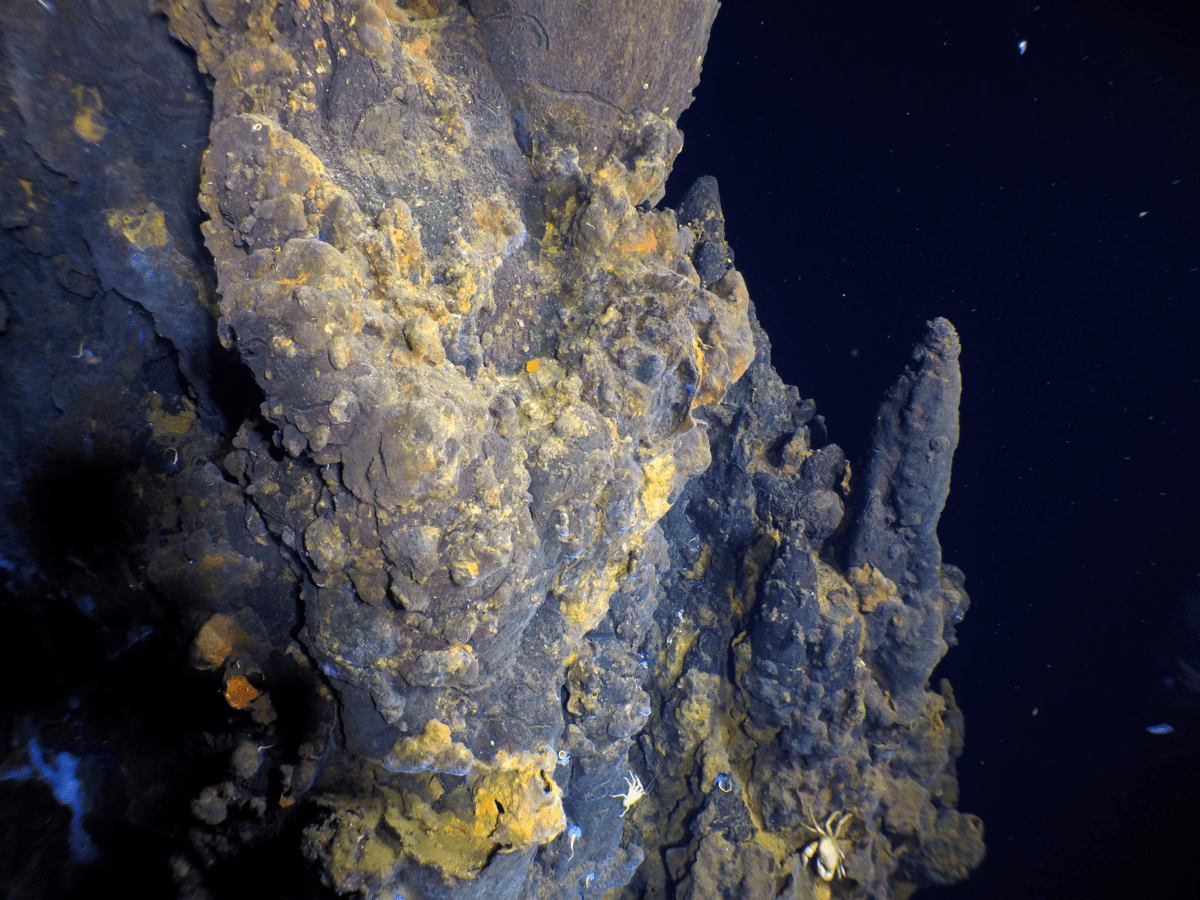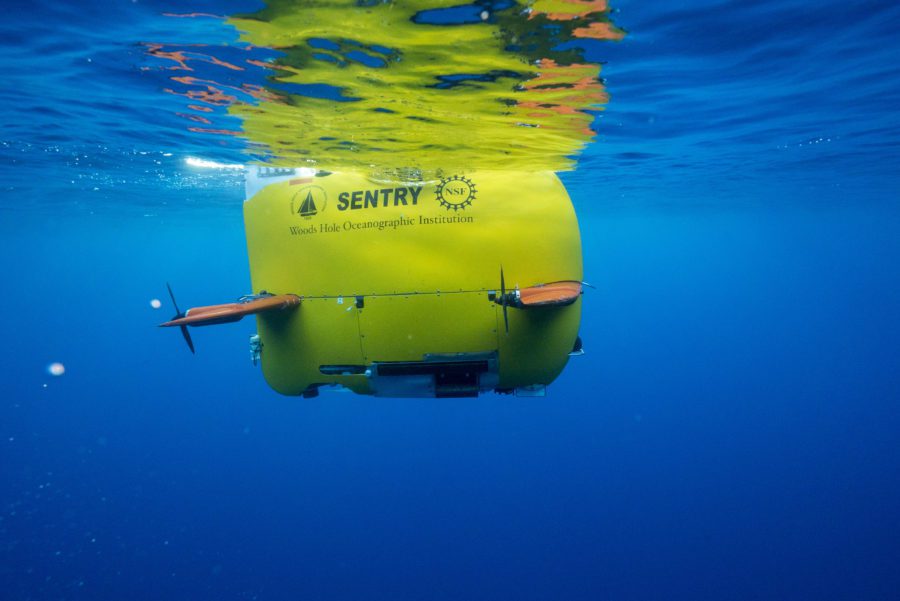Hydrothermal field discovered at the East Pacific Rise 9°54’N
 A new hydrothermal vent was dscovered in 2021 by a collaborative WHOI co-led team. Sulfide structures at the YBW-Sentry vent field have yellow iron staining, and host white Bythograeid crabs. Image credit: Woods Hole Oceanographic Institution, National Deep Submergence Facility, remotely operated vehicle Jason team, WHOI-MISO Facility, National Science Foundation.
A new hydrothermal vent was dscovered in 2021 by a collaborative WHOI co-led team. Sulfide structures at the YBW-Sentry vent field have yellow iron staining, and host white Bythograeid crabs. Image credit: Woods Hole Oceanographic Institution, National Deep Submergence Facility, remotely operated vehicle Jason team, WHOI-MISO Facility, National Science Foundation. July 21, 2022
A newly discovered off-axis, high-temperature hydrothermal field on the East Pacific Rise is named for pioneers of deep-ocean technology innovation.
Woods Hole, MA – A new high-temperature, off-axis hydrothermal vent field on Pacific seafloor at 2,550 meters depth was discovered in 2021 by a team that included researchers from Lehigh University; Scripps Institution of Oceanography (SIO); the University of Bergen Norway; and Woods Hole Oceanographic Institution (WHOI). The discovery could change scientists’ understanding of the impact that seafloor vent systems have on the life and chemistry of Earth’s oceans.
The findings were published today in the Proceedings of the National Academy of Sciences (PNAS).
The team discovered the hydrothermal field along a portion of the global mid-ocean ridge known as the East Pacific Rise about 200 miles off the coast of western Mexico. The new site is roughly twice as large as the nearest active hydrothermal vent fields in the region and its fluids originate at hotter temperatures than other nearby vents. The size and location of the site underscores the likelihood that there are more hydrothermal vents in the deep-sea than previously thought, emphasizing the need for more high-resolution mapping to locate them.
Deep-sea hydrothermal vents are found around the world, often in volcanically active locations along the axis of the global mid-ocean ridge system. Magmatic activity, driven by upwellings of heat from Earth’s mantle, causes the brittle tectonic plates that make up Earth’s outer shell, or crust, to split. As the plates spread, new seafloor is formed by magmatic activity and volcanic eruptions.
This magmatic and tectonic activity creates cracks through which seawater percolates down below the seafloor, where it reacts with minerals in the surrounding rocks and eventually returns to the surface as hot, chemical-rich hydrothermal vent fluids. Where this fluid pours into the seafloor reactions with the cold seawater can produce tall, spire-like chimneys and support complex ecosystems that were unknown to science less than 50 years ago.
According to Daniel J. Fornari, a WHOI marine geologist and a co-author of the study, the newly discovered vent field is unique in several ways. “We were astounded that not only was the field very active, but it is larger in area and hotter than any other hydrothermal vent field known along this portion of the East Pacific Rise that has been studied for the past 30 years,” he said.
Its discovery along such a well-studied region of the seafloor came as a result of improved mapping techniques using the autonomous underwater vehicle (AUV) Sentry operated by the National Deep Submergence Facility at WHOI. The Sentry surveys resulted in maps that resolved details to one-meter resolution and revealed the location of the vent field where no one had looked before.
“The mapping work provides a detailed picture of the seafloor so that we can monitor and quantify changes that occur when the next volcanic eruption happens along this portion of the East Pacific Rise ridge axis,” said Lehigh University marine chemist Jill McDermott, the lead author of the study.
The science team named the vent field YBW-Sentry after three WHOI engineers who are pioneers of autonomous underwater vehicle (AUV) technology—Dana Yoerger, Al Bradley, and Barry Walden. The name also acknowledges Sentry’s role in the discovery and its place as part of a long legacy of AUV innovation at WHOI. According to McDermott, the ways in which scientists study and sample the seafloor have been revolutionized by the high-resolution maps produced by Sentry and its predecessor ABE.
The search for active hydrothermal vents has historically focused on the central trough that marks the axis of the globe-spanning mid-ocean rise and is the locus of most of the volcanic eruptions along the East Pacific Rise. The team has been expanding their high-resolution seafloor map that aids in their quest for new vents west and east of this axial trough between 9° 45-57'N latitude for the past three years using Sentry, and conducted detailed imaging and sample collection missions using NDSF’s other primary assets: the remotely operated vehicle (ROV) Jason and human-occupied vehicle (HOV) Alvin.
The 3-year research project is funded by the US National Science Foundation's Ocean Sciences Division, Marine Geology & Geophysics Program.
Additional authors of the PNAS paper include: Ross Parnell-Turner, Scripps Institution of Oceanography, Thibaut Barreyre, University of Bergen; Santiago Herrera, Nicole C. Pittoors, Samuel A. Vohsen, Connor C. Downing, Kelden Pehr and William S. Dowd (all at Lehigh University); Jyun-Nai Wu, Scripps Institution of Oceanography; and Milena Marjanović, Institut de Physique du Globe de Paris.

